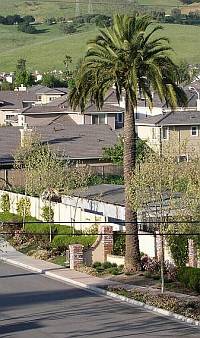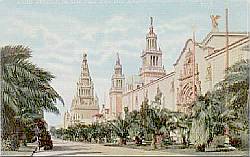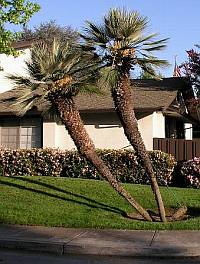
Date palms
Warm Springs District |
From the Canary Island Date palms lining the entrance of the Masonic Home in Union City to the Date palms in front of the Marriott Hotel in Warm Springs, palms add a distinctive accent to our local skyline. Though some think Northern California is too cold for palms, our area is sheltered from most harsh weather conditions and is a palm paradise.
Cultivating palms in California began with the Spanish missionaries, but it wasn't until the American Era that palms were planted locally. One early species here was the Canary Island Date palm (Phoenix canariensis). These are the large and rough trunked trees lining Adelina Common (once the entrance to 'St. Mary of the Palms' school for girls) in Mission San Jose, the entry to the Masonic Home in Union City, and the road in the California Nursery Company Historical Park in Niles. It's an easy-to-grow palm that makes a bold statement, but requires a good deal of maintenance to make it an attractive garden feature.

Canary Island Date palm
Niles District |
Other early palms here were the Mexican Fan palm (Washingtonia robusta) and the California Fan palm (W. filifera). The tall slender palms along Washington Boulevard between Mission San Jose and Irvington are Mexican Fan Palms, as are the ones in the Twenty-eight Palms neighborhood off Blacow Avenue. These palms are also easily grown in this area, but have two drawbacks for the average gardener-they require the pruning of dead leaves, and their height easily exceeds 60 feet when mature. The California Fan palm is the only palm native to the state; its natural range is in the deserts near Palm Springs.
As a sign of wealth, early farmsteads in this area would have a pair of palms at the roadside denoting the entrance gate. If they were wealthier, they would have a whole row of palms leading to their house. E.L. Beard, an early Yankee settler, took it further and planted whole groves of palms on his property and named his estate in Mission San Jose 'Palmdale'.
The next wave of local palm growing came in 1884, with the arrival of John Rock and the California Nursery Company. Rock had established the nursery in Santa Clara County in 1865, but moved it to Niles in 1884. Though Rock focused on providing every kind of grape, fruit and nut trees for California's vineyards and orchards, he also sold ornamental plants for gardens and parks. Rock is considered the "Father" of palm cultivation in California. With the California Nursery Company, he did extensive experimentation with palm varieties, and by 1876, was able to offer 10,000 palm trees for sale. Rock, in his 1898 nursery catalog, states that "Palms have become almost indispensable in all decorations, whether for apartments or conservatories, or the production of tropical effects in landscapes."

Chilean Wine palms
Shinn House |
One species Rock brought to Niles was the Chilean Wine palm (Jubaea chilensis). This is a massive tree with a trunk 4 to 5 feet in diameter. Its seeds are tiny coconuts that have sweet milk and meat. There are two Chilean Wine palms at the Shinn House and Arboretum, and they are the largest trees of their kind in California. These trees are excellent in the garden because of their slow growth, lack of thorns and the self-pruning of dead leaves. They are the most expensive palm available and cost over $1,000 per vertical foot of trunk.
The California Nursery Company supplied all the palm trees for the 'Panama-Pacific International Exposition' in San Francisco. This event held in 1915, is considered the quintessential World Fair, and palms were an important design feature of its landscaping. William Landers, President of the nursery after Rock's death in 1904, boasted in the 1915 catalog that not one of over 100 palms died due to their transport to San Francisco from Niles.

Avenue of the Palms
PPIE San Francisco |
In 1917, George C. Roeding purchased the California Nursery Company. He expanded Rock's ornamental tree market with nursery grounds in Fresno and the Central Valley. Roeding stated in the 1929 catalog that "No class of plants lends itself more harmoniously to a California landscape than do the palms. Palms are especially desirable, both the feathery and the fan-shaped species, for giving the effect that at once suggests tropical conditions."

Mediterranean Fan palms
Niles District |
Palms are on the City of Fremont's 'Landmark Tree' list of 1971 (you can view the tree list on-line at www.museumoflocalhistory.org). Palms on the list include the Chilean Wine and Canary Island Date palms, and the California, Mexican and Mediterranean (Chamaerops humilis) fan palms. The Mediterranean Fan palm is considered the most drought and frost hardy palm species available, and it's an excellent garden accent because it only grows to about 15 feet tall.
Herb Rezentes, Fremont Park Superintendent, who recently retired after 32 years of service for the Parks Department, is a palm fan. Rezentes, along with Bob Fowler of the International Palm Society and Fremont's Urban forestry, organized the planting of a row of Guadelupe Island (Brahea edulis) and San Jose Hesper (B. brandegeei) palms along Palm Ave. in Mission San Jose. These palms are great for streetside locations because of their compact spread and relatively short height. Rezentes also recommends the reestablishment of a full row of Canary Island Date palms in the California Nursery Historical Park so that the park keeps its palm heritage.
Shig Nakamura of Naka Nursery is also continuing the tradition of local palm cultivation. Nakamura's commercial nursery is located on leased land within the California Nursery Company Historical Park. He is growing out a large number of cold hardy species that will do well in any garden.
There are at least 23 separate species of palms growing locally in private gardens, businesses and public parks. Fremont is very palm friendly, and Newark and Union City aren't far behind. The 'Roadside Arboretum of Washington Township' has a list of palms in the area and provides a photograph and map of their location. Go on-line to www.fremontica.com to view the arboretum's web pages. The International Palm Society-Northern California Chapter have their web pages here too.
The best places to view unusual palms in this area include:
Ohlone College-the Pine Street entrance has a number of date palm species including Canary Island Date, Cliff Date (P. rupicola), Mountain Date (P. loureirii) and the true Date (P. dactylifera) palm.
Shinn House and Arboretum-1251 Peralta Blvd. has the Chilean Wine palms.
The California Nursery Company Historical Park-36501 Niles Blvd. has an excellent selection of palms scattered throughout the park including a large Senegal Date (P. reclinata), Silver Date (P. sylvestris), Canary Island Date, Pindo (Butia capitata), Kentia (Howea forsteriana), Mediterranean Fan and Chinese Windmill palms.
Palmdale, at the north entrance to Mission San Jose is a private park, but is open to the public for special events. Lots of palms and many other trees too.
Originally published in the Tri-City Voice of Fremont, Newark and Union City. April 13, 2004.
|